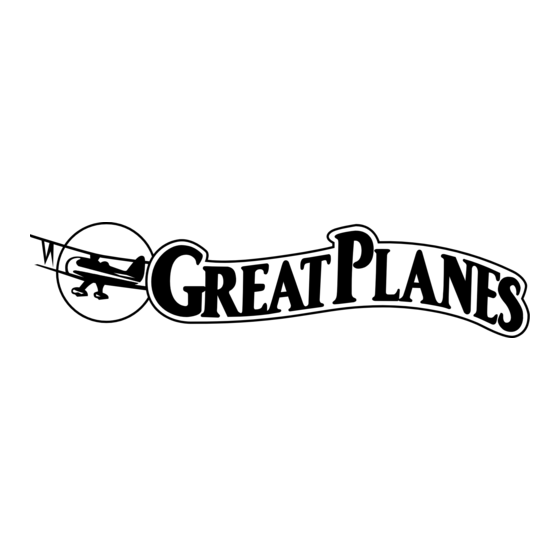GREAT PLANES Wright Flyer Instruction Manual - Page 13
Browse online or download pdf Instruction Manual for Toy GREAT PLANES Wright Flyer. GREAT PLANES Wright Flyer 16 pages. Almost ready to fly electric powered r/c airplane

2. Lift the model, upside-down, at the balance point you
marked on fuselage rails. This is easiest to do with a piece
of wire or the edge of a ruler.
3. If the tail drops, the model is "tail heavy" and the
battery pack and/or receiver must be shifted forward or
weight must be added to the nose to balance. If the nose
drops, the model is "nose heavy" and the battery pack
and/or receiver must be shifted aft or weight must be added
to the tail to balance. If possible, relocate the battery pack
and receiver to minimize or eliminate any additional ballast
required. If additional weight is required, use Great Planes
(GPMQ4485) "stick-on" lead. If weight is required in the tail, it
can be stuck to the bottom of the rudder support. If weight is
required in the nose it can be attached to the battery holder.
4. IMPORTANT: If you found it necessary to add any
weight, recheck the C.G. after the weight has been added to
confirm that it is correct.
Our prototype model required 1/8 ounce [3.5 grams] on the
front of the model.
PREFLIGHT
Identify Your Model
No matter if you fly at an AMA sanctioned R/C club site or if
you fly somewhere on your own, you should always have
your name, address, telephone number and AMA number
on or inside your model. It is required at all AMA R/C club
flying sites and AMA sanctioned flying events. Fill out the
identification tag on the back cover page and place it on or
inside your model.
Charge the Transmitter Batteries
Be certain the transmitter batteries are fully charged. Follow
the battery charging instructions that came with your radio
control system to charge the batteries. You should always
charge your batteries the night before you go flying, and at
other times as recommended by the radio manufacturer.
Ground Inspection
Before you fly you should perform one last overall inspection
to make sure the model is truly ready to fly and that you
haven't overlooked anything. If you are not thoroughly
familiar with the operation of R/C models, ask an
experienced modeler to perform the inspection. Check to
see that you have the radio installed correctly and that all
the controls are connected properly. The motors must also
be checked by confirming that the props are rotating in the
correct direction and the motors sound like they are
reaching full power. Make certain the ailerons and elevators
are secure, the pushrods are connected, the controls
respond in the correct direction, radio components are
securely mounted, and the C.G. is correct.
Range Check
Ground check the operational range of your radio before the
first flight of the day. With the transmitter antenna collapsed
and the receiver and transmitter on, you should be able to
walk at least 100 feet away from the model and still have
control. Have an assistant stand by your model and, while
you work the controls, tell you what the control surfaces are
doing. Repeat this test with the motors running at various
speeds with an assistant holding the model, using hand
signals to show you what is happening. If the control
surfaces do not respond correctly, do not fly! Find and
correct the problem first. Look for loose servo connections
or broken wires, corroded wires on old servo connectors,
poor solder joints in your battery pack or a defective cell, or
a damaged receiver crystal from a previous crash.
Performance Tips
• Use fine sandpaper to remove imperfections along the
edges of the propeller. For the best performance, use a
Top
Flite
®
Precision
(TOPQ5700) to balance the propellers (this is a necessity
on glow-powered engines, but less critical on small
electric models).
• Using multiple battery packs for successive flights may
cause the motors to become excessively hot, thus
causing damage. Allow the motors to cool for at least 10
minutes between flights.
13
Magnetic
Prop
Balancer
™
